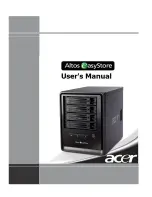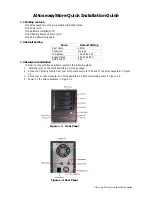
If all hard disks fail, the system automatically detects this and stays
operational; however, the system remains volatile until three new hard
drives are replaced. When the new drives are replaced, the system
rebuilds the drives from the system memory image.
Use the following steps to replace bad disk drives:
1. Verify that disk synchronization is not in progress. If one is in
progress, then wait for the synchronization to complete before
continuing.
2. Slide the hard disk eject latch to the right.
3. Remove the hard disk by pulling squarely on the handle.
4. Insert new hard disk squarely into the available slot. Ensure the disk
drive is completely inserted into the system and flush with the chassis.
Warning:
The system erases any pre-existing data on hard disk drives inserted into
the RamSan-320 while the system is running.
Important:
TMS does not advise removing functional hard disks. While the action
should be perfectly safe, it may affect system performance or downtime,
depending on the system mode, as the system synchronizes the new disk
drive.
8.3 Batteries
The RamSan-320 is equipped with three redundant 30-minute Lithium Ion
batteries. The batteries are designed to protect the data in SDRAM
memory. If the RamSan-320 looses external power, the system continues
to function by running on the internal batteries. Even if both power
supplies are removed or fail, the batteries will continue to operate.
The system stays on for at most five minutes after power fails. If power is
restored within this time, the system will stay online.
If the batteries are not fully charged, the system may initiate a shutdown
before the allotted time is up. This ensures that the system protects the
data in memory by storing it to disk. If running in DataSync mode, the
shutdown operation takes approximately one minute for every four
Gigabytes of capacity as the system synchronizes data on the disks.
8.4 Fans
The system has one block of ten fans. The fan block is accessed from the
top of the chassis.
RamSan-300/320
User’s Manual
- 77 -










































